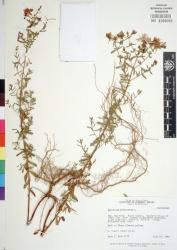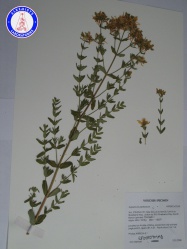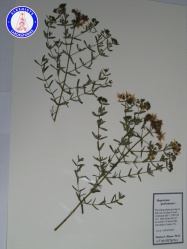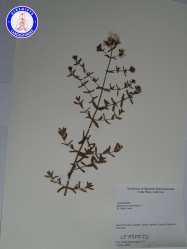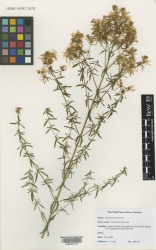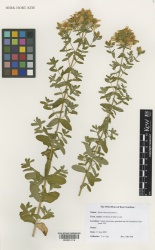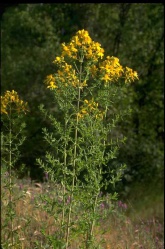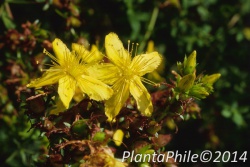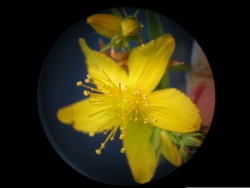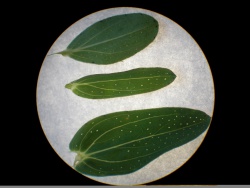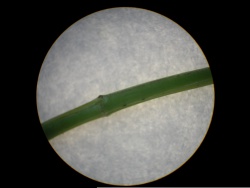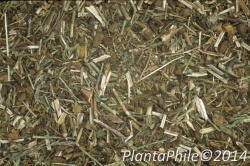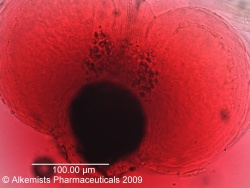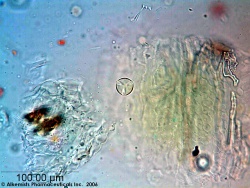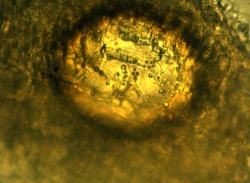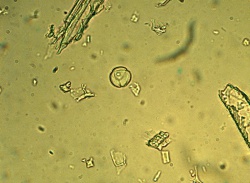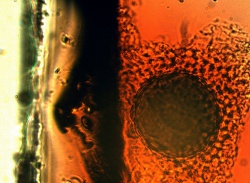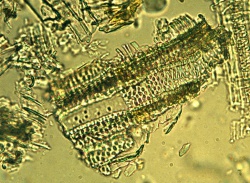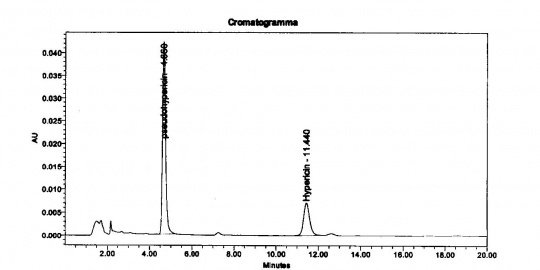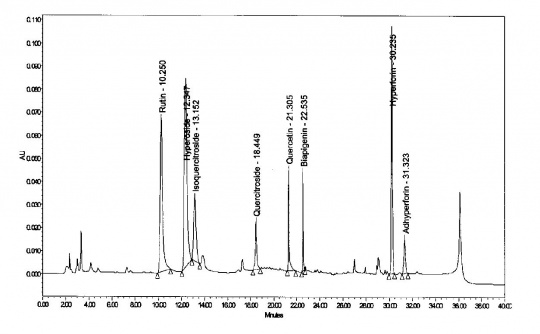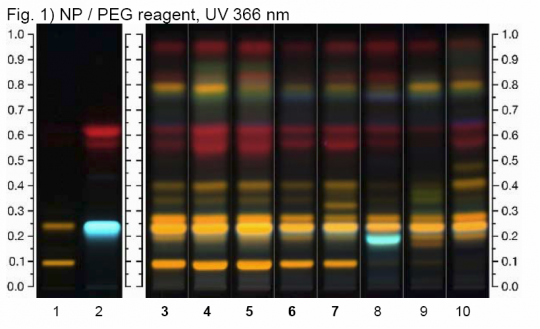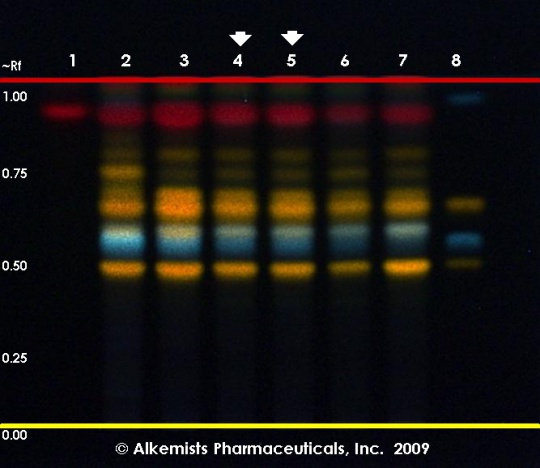Hypericum perforatum (flowering tops)
(add USD 1918 organoleptic information) |
|||
| (38 intermediate revisions by 4 users not shown) | |||
| Line 1: | Line 1: | ||
| − | + | {{DISPLAYTITLE:''Hypericum perforatum'' (flowering tops)}} {{askbox|herb=''Hypericum perforatum''}} | |
| − | '' | + | =Nomenclature= |
| − | + | {{nomenclature | binomial=Hypericum perforatum | |
| + | |authority=L. | ||
| + | |family=Clusiaceae | ||
| + | |scn=St. John's wort | ||
| + | |syn= | ||
| + | |ayurvedic= | ||
| + | |pinyin= | ||
| + | |aka= | ||
| + | |notes= }} | ||
| − | + | =Botanical Voucher Specimen= | |
| − | + | {{Media4 |cat=Voucher | |
| + | |||
| + | |source=MOBOT, Tropicos.org. | ||
| + | |mainimage=St. John's Wort Tropicos 61762.jpg | ||
| + | |companyimage=TropicosLogo.gif | ||
| + | |companyURL=http://www.tropicos.org/Image/61762 | ||
| + | |||
| + | |source2=Botanical Voucher Specimen Library, Alkemists Laboratories | ||
| + | |image2=Hypericum perforatum LF00509MMB A0153.jpg | ||
| + | |companyimage2=AP-LOGO-Laboratories Crop - Copy.jpg | ||
| + | |companyURL2=http://www.alkemist.com | ||
| + | |||
| + | |source3=Botanical Voucher Specimen Library, Alkemists Laboratories | ||
| + | |image3=Hypericum perforatum LF20105BMX1 A0155.jpg | ||
| + | |companyimage3=AP-LOGO-Laboratories Crop - Copy.jpg | ||
| + | |companyURL3=http://www.alkemist.com | ||
| − | + | |source4=Botanical Voucher Specimen Library, Alkemists Laboratories | |
| + | |image4=Hypericum perforatum LF19505JD A0154.jpg | ||
| + | |companyimage4=AP-LOGO-Laboratories Crop - Copy.jpg | ||
| + | |companyURL4=http://www.alkemist.com | ||
| − | + | |}} | |
| − | + | {{Media2 | cat=Voucher | |
| + | |||
| + | | source=Royal Botanic Gardens, Kew. | ||
| + | | companyimage=Kewlogo.gif | ||
| + | | companyURL=http://specimens.kew.org/herbarium/K000914115 | ||
| + | | mainimage=Hypericum_perforatum_Kew_imageBarcode%3DK000914115_479681.jpg | ||
| + | |||
| + | | source2=Royal Botanic Gardens, Kew. | ||
| + | | companyimage2=Kewlogo.gif | ||
| + | | companyURL2=http://specimens.kew.org/herbarium/K000914116 | ||
| + | | image2=Hypericum_perforatum_Kew_imageBarcode%3DK000914116_479682.jpg | ||
| − | |||
| − | + | | }} | |
| − | + | ||
| − | + | ||
| − | + | ||
| − | + | ||
| − | + | ||
| − | + | ||
| − | + | ||
| − | = | + | =Organoleptic Characteristics= |
| − | {{ | + | {{Organolepsy | source=United States Dispensatory (1918) |
| − | + | | description=[''Hypericum perforatum'' ...] a peculiar balsamic odor, which is rendered more sensible by rubbing or bruising the plant. Its taste is bitter, resinous, and somewhat astringent.}} | |
| − | + | ||
| − | + | ||
| − | + | ||
| − | + | ||
| − | + | ||
| − | + | ||
| − | + | ||
| − | + | ||
| − | + | ||
| − | + | =Macroscopic Characteristics= | |
| − | + | {| border=1 | |
| − | + | | | |
| − | + | ||
| − | + | ||
| − | + | ||
| − | + | ||
| − | + | ||
| − | + | ||
| − | + | ||
| − | + | ||
| + | {{Media3 |cat=Macroscopy |companyimage= AHPLogoWeb.jpg | ||
| + | | companyURL= http://www.herbal-ahp.org/ | ||
| − | = | + | |companyimage3= AHPLogoWeb.jpg |
| − | + | | companyURL3= http://www.herbal-ahp.org/ | |
| − | | | + | |mainimage= Hypericum perforatum 1 RU.jpg |
| − | | | + | |caption1= ''Hypericum perforatum'' growing in the field |
| − | + | |source= Roy Upton, American Herbal Pharmacopoeia® | |
| − | + | | source2=PlantaPhile | |
| − | | | + | | image2=PlantaPhile_-_146.jpg |
| − | | | + | | companyimage2=PlantaPhile logo.jpg |
| − | + | | companyURL2=http://plantaphile.com/ | |
| − | | | + | |image3= Hypericum blossom stereo 2.jpg |
| − | | | + | |caption3= ''Hypericum perforatum'' flower close-up. Note the black dots on the petals' margin only. |
| − | | | + | |source3= American Herbal Pharmacopoeia® |
| + | }} | ||
| + | |||
| + | {{Media3 |cat=Macroscopy | ||
| + | |companyimage= AHPLogoWeb.jpg | ||
| + | | companyURL= http://www.herbal-ahp.org/ | ||
| + | |mainimage= Hypericum_perforatum_leaves_stereo_1.JPG | ||
| + | |caption1= ''Hypericum perforatum'' leaves with the characteristic black dots on the margin and translucent dots on the leaf body. | ||
| + | |source=American Herbal Pharmacopoeia® | ||
| + | |companyimage2= AHPLogoWeb.jpg | ||
| + | | companyURL2= http://www.herbal-ahp.org/ | ||
| + | |image2= Hypericum perforatum stem stereo 2.JPG | ||
| + | |caption2= ''Hypericum perforatum'' stem showing opposite ridges, a defining characteristic of the species. | ||
| + | |source2= American Herbal Pharmacopoeia® | ||
| + | | source3=PlantaPhile | ||
| + | | image3=PlantaPhile - 2611.jpg | ||
| + | | companyimage3=PlantaPhile logo.jpg | ||
| + | | companyURL3=http://plantaphile.com/ | ||
| + | | | ||
| − | |||
| − | |||
| − | |||
| − | |||
| − | |||
| − | |||
| − | |||
| − | |||
| − | |||
| − | |||
| − | |||
| − | |||
| − | |||
| }} | | }} | ||
| + | |} | ||
| + | =Microscopic Characteristics= | ||
| + | {| border=1 | ||
| + | | | ||
| − | =HPTLC | + | {{Media4 |cat=Microscopy |companyimage= AP-LOGO-Laboratories Crop - Copy.jpg |
| + | | companyURL= http://www.alkemist.com | ||
| + | |companyimage2= AP-LOGO-Laboratories Crop - Copy.jpg | ||
| + | | companyURL2= http://www.alkemist.com | ||
| + | |companyimage3= PhytoLab_Logo.jpg | ||
| + | | companyURL3= http://www.phytolab.com/en.html | ||
| + | |companyimage4= PhytoLab_Logo.jpg | ||
| + | | companyURL4= http://www.phytolab.com/en.html} | ||
| + | |mainimage=Hypericum_perforatum_L._-Clusiaceae--1.jpg | ||
| + | |caption1= Oil glands with red pigment of ''Hypericum perforatum'' viewed at 400x with Acidified Chloral Hydrate Solution. | ||
| + | |source= Elan M. Sudberg, Alkemist Laboratories | ||
| + | |image2=Hypericum_perforatum_L._-Clusiaceae--2.jpg | ||
| + | |caption2= Three pored pollen grain showing smooth and faintly warted exine of ''Hypericum perforatum'' viewed at 400x with Acidified Chloral Hydrate Solution. | ||
| + | |source2= Elan M. Sudberg, Alkemist Laboratories | ||
| + | |image3=st johns wort secretory cell phytolab.jpg | ||
| + | |caption3= St. John's Wort, ''Hyperici herba'' secretory cell | ||
| + | |source3= Claudia Borst, PhytoLab | ||
| + | |image4=st johns wort pollen grain phytolab.jpg | ||
| + | |caption4= St. John's Wort, ''Hyperici herba'' pollen grain | ||
| + | |source4= Claudia Borst, PhytoLab | ||
| + | }} | ||
| + | |||
| + | {{Media2 |cat=Microscopy |companyimage= PhytoLab_Logo.jpg | ||
| + | | companyURL= http://www.phytolab.com/en.html | ||
| + | |companyimage2= PhytoLab_Logo.jpg | ||
| + | | companyURL2= http://www.phytolab.com/en.html | ||
| + | |mainimage=st johns wort hypericin gland phytolab.jpg | ||
| + | |caption1= St. John's Wort, ''Hyperici herba'' hypericin gland | ||
| + | |source= Claudia Borst, PhytoLab | ||
| + | |image2=st johns wort tracheidal vessels with pitted walls phytolab.jpg | ||
| + | |caption2= St. John's Wort, ''Hyperici herba'' tracheidal vessels with pitted walls | ||
| + | |source2= Claudia Borst, PhytoLab }} | ||
| + | |||
| + | |||
| + | |} | ||
| + | |||
| + | =High Performance Liquid Chromatographic Identification= | ||
| + | {| style="width: 100%" border=1 | ||
| + | | | ||
| + | {{Botanical | source=Indena S.p.A. | ||
| + | | companyURL=http://www.indena.com/ | ||
| + | | companyimage=Indena - Logo.png | ||
| + | |mainimage=Indena - St. John's Wort Info - hypericin hplc.jpg | ||
| + | |caption1=Total hypericins representative chromatogram | ||
| + | |||
| + | | | ||
| + | | description= | ||
| + | '''Method for Hypericins''' | ||
| + | |||
| + | '''Column:''' 15-cm x 4.6 mm, 5-um, Waters Atlantis C18 | ||
| + | |||
| + | '''Mobile Phase:''' A mix of 39 volumes of ethyl acetate, 41 volumes of a 15.6 g/L solution of sodium dihydrogen phosphate adjusted to pH 2 with phosphoric acid and 160 volumes of methanol. | ||
| + | |||
| + | '''Elution:''' Isocratic | ||
| + | |||
| + | '''Column Temperature:''' 40°C | ||
| + | |||
| + | '''Flow rate:''' 1.0 mL/min | ||
| + | |||
| + | '''Detection:''' Vis, 590 nm | ||
| + | |||
| + | '''Injection volume:''' 20 uL | ||
| + | }} | ||
| + | |} | ||
| + | |||
| + | |||
| + | {| style="width: 100%" border=1 | ||
| + | | | ||
| + | {{Botanical | source=Indena S.p.A. | ||
| + | | companyURL=http://www.indena.com/ | ||
| + | | companyimage=Indena - Logo.png | ||
| + | |mainimage=Indena - St. John's Wort Info - hyperforin and flavonoids hplc.jpg | ||
| + | |caption1=Hyperforins and flavonoids representative chromatogram | ||
| + | | | ||
| + | | description= | ||
| + | '''Method for Hyperforins and Flavonoids''' | ||
| + | |||
| + | '''Column:''' 15-cm x 4.6 mm, 3-um, YMC-Pack ODS-A | ||
| + | |||
| + | '''Mobile Phase:''' Water, containing 0.3 % (v/v) phosphoric acid 85% (Solution A) and acetonitrile containing 0.3 % (v/v) phosphoric acid 85% (Solution B) | ||
| + | |||
| + | '''Elution:''' Gradient, see table below | ||
| + | |||
| + | '''Column Temperature:''' 25°C | ||
| + | |||
| + | '''Detection:''' UV, 360 nm, then at 275 nm after the elution of biapigenin (about 22 min) | ||
| + | |||
| + | '''Injection volume:''' 10 uL }} | ||
| + | |||
| + | |||
| + | ===Table: Gradient program=== | ||
| + | |||
| + | {| border=1 | ||
| + | | Time (min) || Solution A (%) || Solution B (%) || Flow Rate (mL/min) | ||
| + | |- | ||
| + | | 0-8 || 82 || 18 || 0.8 | ||
| + | |- | ||
| + | | 8-18 || 82-47 || 18-53 || 0.8 | ||
| + | |- | ||
| + | | 18-18.1 || 47-3 || 53-97 || 0.8 | ||
| + | |- | ||
| + | | 18.1-19 || 3 || 97 || 1.2 | ||
| + | |- | ||
| + | | 19-29 || 3 || 97 || 1.2 | ||
| + | |- | ||
| + | | 29-30 || 82 || 18 || 1.2 | ||
| + | |- | ||
| + | | 30-31 || 82 || 18 || 0.8 | ||
| + | |- | ||
| + | | 31-35 || 82 || 18 || 0.8 | ||
| + | |} | ||
| + | |} | ||
| + | =High Performance Thin Layer Chromatographic Identification= | ||
| + | {{HPTLC | source=HPTLC Association | ||
| + | | companyimage=HPTLC-assoc-Logo-farbig-Text-schwarz-300x47.png | ||
| + | | companyURL=http://www.hptlc-association.org/ | ||
| + | | mainimage=HPTLC Hypericum Perforatum - hptlc - uv 366nm.png | ||
| + | | caption1=''Hypericum perforatum'' HPTLC, UV 366 nm | ||
| + | | description=St. John's wort (herb) (''Hypericum perforatum'') | ||
| + | | | ||
| + | | lanes=Lanes, from left to right (Track, Volume, Sample): | ||
| + | # 2 μL Rutin, Hyperoside (increasing Rf) | ||
| + | # 2 μL Chlorogenic acid, Hypericin, Pseudohypericin (increasing Rf) | ||
| + | # 4 μL St. John's wort herb 1 | ||
| + | # 4 μL St. John's wort herb 2 | ||
| + | # 4 μL St. John's wort herb 3 | ||
| + | # 4 μL St. John's wort herb 4 | ||
| + | # 4 μL St. John's wort herb 5 | ||
| + | # 4 μL Mountain St. John's wort herb | ||
| + | # 4 μL Hairy St. John's wort herb | ||
| + | # 4 μL Wavy St. John's wort herb | ||
| + | | notes=<br> | ||
| + | '''Reference Standard Solution:''' 1.0 mg/mL rutin in methanol, 0.1 mg/mL hyperoside, 0.1 mg/mL hypericin and 0.1 mg/mL pseudohypericin (sonicate for 10 min, centrifuge, and use the supernatant), and 1.0 mg/mL chlorogenic acid in methanol (optional). | ||
| + | |||
| + | '''Reference Sample Preparations:''' Sonicate 0.5 g of powdered sample in 5 mL of methanol at 60°C, centrifuge or filter the solution, and use the supernatant / filtrate. | ||
| + | |||
| + | '''Stationary Phase:''' HPTLC, Silica gel 60 F254 | ||
| + | |||
| + | '''Mobile Phase:''' Ethyl acetate, dichloromethane, water, formic acid, acetic acid (100:25:11:10:10) | ||
| + | |||
| + | '''Development:''' Saturate chamber for 20 minutes; developing distance 70 mm from lower edge of the plate; relative humidity 33%, temperature 25°. | ||
| + | |||
| + | '''Derivatization reagent A:''' Natural Products Reagent (NP)– 5 mg/mL 2-aminoethyl diphenylborinate in ethyl acetate in a glass bottle. | ||
| + | |||
| + | '''Derivatization reagent B:''' PEG Reagent– 50 mg/mL polyethylene glycol 400 (macrogol) in dichloromethane in a glass bottle. | ||
| + | |||
| + | '''Detection:''' Heat plate at 100°C for 3 min, dip (time 0, speed 5) in Derivatization reagent A, dry, dip (time 0, speed 5) in Derivatization reagent B, and examine under UV light at 366 nm. | ||
| + | |||
| + | '''System suitability:''' ''Rutin:'' orange fluorescent zone in the lower one-third of the plate at about Rf 0.1. ''Hyperoside:'' orange fluorescent zone in the lower one-third of the plate at about Rf 0.25. | ||
| + | |||
| + | '''Procedure:''' | ||
| + | |||
| + | ''Reference Standard Solutions, Stationary Phase, Mobile Phase, Development, Derivatization reagent A, Derivatization reagent B, and Detection, as described above.'' | ||
| + | |||
| + | '''Test Sample Preparation:''' Prepare test sample as described under Reference Sample Preparations and apply 4 uL. | ||
| + | |||
| + | '''Identification:''' Compare Test Sample Preparation chromatogram with chromatograms of Reference Sample Preparations. The Test Sample Preparation chromatogram is similar to that of the Reference Sample Preparations chromatograms. Additional weak zones may be present. | ||
| + | |||
| + | The Test Sample Preparation chromatogram exhibits fluorescent zones corresponding to the zones due to rutin, hyperoside, hypericin, and pseudohypericin in the Reference Standard Solution chromatograms. Between the zones due to hyperoside and hypericin there are several orange fluorescent zones. | ||
| + | |||
| + | '''Related Species:''' A very faint zone at the Rf corresponding to rutin indicating Hypericum montanum (mountain St. John’s Wort), Hypericum hirsutum (hairy St. John’s Wort), or Hypericum undulatum (wavy St. John’s Wort). A blue fluorescent zone detected below and well resolved from the hyperoside zone indicating Hypericum montanum. Two yellow zones detected around one-third of the chromatogram indicating Hypericum hirsutum. An orange zone detected at Rf 0.47 indicating Hypericum undulatum. | ||
| + | |||
| + | ''Note: Images presented in this entry are examples and are not intended to be used as a bases for setting specifications for quality control purposes.''}} | ||
| + | |||
| + | <br> | ||
{{HPTLC | source=Elan M. Sudberg, Alkemist Laboratories | {{HPTLC | source=Elan M. Sudberg, Alkemist Laboratories | ||
| description=St. John's Wort (herb) (''Hypericum perforatum'') | | description=St. John's Wort (herb) (''Hypericum perforatum'') | ||
| Line 106: | Line 292: | ||
| }} | | }} | ||
| − | = | + | =Supplementary Information= |
| + | |||
| + | =Sources= | ||
| + | |||
| + | <references /> | ||
| + | [[Category:Botanical]] | ||
Latest revision as of 18:16, 17 March 2015
Contents |
Nomenclature
Hypericum perforatum L. Clusiaceae
Standardized common name (English): St. John's wort
Botanical Voucher Specimen
 |
 |
 |
|
|
|
|
|
|
 |
 |
|
|
|
Organoleptic Characteristics
|
Macroscopic Characteristics
|
Microscopic Characteristics
|
High Performance Liquid Chromatographic Identification
|
'Method for Hypericins Column: 15-cm x 4.6 mm, 5-um, Waters Atlantis C18 Mobile Phase: A mix of 39 volumes of ethyl acetate, 41 volumes of a 15.6 g/L solution of sodium dihydrogen phosphate adjusted to pH 2 with phosphoric acid and 160 volumes of methanol. Elution: Isocratic Column Temperature: 40°C Flow rate: 1.0 mL/min Detection: Vis, 590 nm Injection volume: 20 uL Source: Indena S.p.A. [20] |
|
'Method for Hyperforins and Flavonoids Column: 15-cm x 4.6 mm, 3-um, YMC-Pack ODS-A Mobile Phase: Water, containing 0.3 % (v/v) phosphoric acid 85% (Solution A) and acetonitrile containing 0.3 % (v/v) phosphoric acid 85% (Solution B) Elution: Gradient, see table below Column Temperature: 25°C Detection: UV, 360 nm, then at 275 nm after the elution of biapigenin (about 22 min) Injection volume: 10 uL Source: Indena S.p.A. [21] Table: Gradient program
|
High Performance Thin Layer Chromatographic Identification
|
St. John's wort (herb) (Hypericum perforatum) Lane Assignments Lanes, from left to right (Track, Volume, Sample):
Other Notes Reference Sample Preparations: Sonicate 0.5 g of powdered sample in 5 mL of methanol at 60°C, centrifuge or filter the solution, and use the supernatant / filtrate. Stationary Phase: HPTLC, Silica gel 60 F254 Mobile Phase: Ethyl acetate, dichloromethane, water, formic acid, acetic acid (100:25:11:10:10) Development: Saturate chamber for 20 minutes; developing distance 70 mm from lower edge of the plate; relative humidity 33%, temperature 25°. Derivatization reagent A: Natural Products Reagent (NP)– 5 mg/mL 2-aminoethyl diphenylborinate in ethyl acetate in a glass bottle. Derivatization reagent B: PEG Reagent– 50 mg/mL polyethylene glycol 400 (macrogol) in dichloromethane in a glass bottle. Detection: Heat plate at 100°C for 3 min, dip (time 0, speed 5) in Derivatization reagent A, dry, dip (time 0, speed 5) in Derivatization reagent B, and examine under UV light at 366 nm. System suitability: Rutin: orange fluorescent zone in the lower one-third of the plate at about Rf 0.1. Hyperoside: orange fluorescent zone in the lower one-third of the plate at about Rf 0.25. Procedure: Reference Standard Solutions, Stationary Phase, Mobile Phase, Development, Derivatization reagent A, Derivatization reagent B, and Detection, as described above. Test Sample Preparation: Prepare test sample as described under Reference Sample Preparations and apply 4 uL. Identification: Compare Test Sample Preparation chromatogram with chromatograms of Reference Sample Preparations. The Test Sample Preparation chromatogram is similar to that of the Reference Sample Preparations chromatograms. Additional weak zones may be present. The Test Sample Preparation chromatogram exhibits fluorescent zones corresponding to the zones due to rutin, hyperoside, hypericin, and pseudohypericin in the Reference Standard Solution chromatograms. Between the zones due to hyperoside and hypericin there are several orange fluorescent zones. Related Species: A very faint zone at the Rf corresponding to rutin indicating Hypericum montanum (mountain St. John’s Wort), Hypericum hirsutum (hairy St. John’s Wort), or Hypericum undulatum (wavy St. John’s Wort). A blue fluorescent zone detected below and well resolved from the hyperoside zone indicating Hypericum montanum. Two yellow zones detected around one-third of the chromatogram indicating Hypericum hirsutum. An orange zone detected at Rf 0.47 indicating Hypericum undulatum. Note: Images presented in this entry are examples and are not intended to be used as a bases for setting specifications for quality control purposes.
|
|
St. John's Wort (herb) (Hypericum perforatum) Lane Assignments Lanes, from left to right (Track, Volume, Sample):
Reference materials used here have been authenticated by macroscopic, microscopic &/or TLC studies according to the reference source cited below held at Alkemists Laboratories, Costa Mesa, CA. Stationary Phase Silica gel 60, F254, 10 x 10 cm HPTLC plates Mobile Phase ethyl acetate: Acetic acid: HCOOH: H2O [10/1.1/1.1/2.4] Sample Preparation Method 0.3 g + 3 ml 70% grain EtOH sonicated + heated @ 50° C ~ 1 hr Detection Method Natural Product Reagent + PEG -> UV 365 nm Reference see British Pharmacopoeia, 2003
|
Supplementary Information
Sources
- ↑ MOBOT, Tropicos.org. http://www.tropicos.org/Image/61762
- ↑ Botanical Voucher Specimen Library, Alkemists Laboratories http://www.alkemist.com
- ↑ Botanical Voucher Specimen Library, Alkemists Laboratories http://www.alkemist.com
- ↑ Botanical Voucher Specimen Library, Alkemists Laboratories http://www.alkemist.com
- ↑ Royal Botanic Gardens, Kew. http://specimens.kew.org/herbarium/K000914115
- ↑ Royal Botanic Gardens, Kew. http://specimens.kew.org/herbarium/K000914116
- ↑ United States Dispensatory (1918)
- ↑ Roy Upton, American Herbal Pharmacopoeia® http://www.herbal-ahp.org/
- ↑ PlantaPhile http://plantaphile.com/
- ↑ American Herbal Pharmacopoeia® http://www.herbal-ahp.org/
- ↑ American Herbal Pharmacopoeia® http://www.herbal-ahp.org/
- ↑ American Herbal Pharmacopoeia® http://www.herbal-ahp.org/
- ↑ PlantaPhile http://plantaphile.com/
- ↑ Elan M. Sudberg, Alkemist Laboratories http://www.alkemist.com
- ↑ Elan M. Sudberg, Alkemist Laboratories http://www.alkemist.com
- ↑ Claudia Borst, PhytoLab http://www.phytolab.com/en.html
- ↑ Claudia Borst, PhytoLab http://www.phytolab.com/en.html}
- ↑ Claudia Borst, PhytoLab http://www.phytolab.com/en.html
- ↑ Claudia Borst, PhytoLab http://www.phytolab.com/en.html
- ↑ Indena S.p.A. http://www.indena.com/
- ↑ Indena S.p.A. http://www.indena.com/
- ↑ HPTLC Association http://www.hptlc-association.org/
- ↑ Elan M. Sudberg, Alkemist Laboratories http://www.alkemist.com
- Botanical
- Clusiaceae
- Media
- Voucher
- MOBOT, Tropicos.org.
- Botanical Voucher Specimen Library, Alkemists Laboratories
- Royal Botanic Gardens, Kew.
- Organolepsy
- United States Dispensatory (1918)
- Macroscopy
- Roy Upton, American Herbal Pharmacopoeia®
- PlantaPhile
- American Herbal Pharmacopoeia®
- Microscopy
- Elan M. Sudberg, Alkemist Laboratories
- Claudia Borst, PhytoLab
- Indena S.p.A.
- HPTLC
- HPTLC Association
